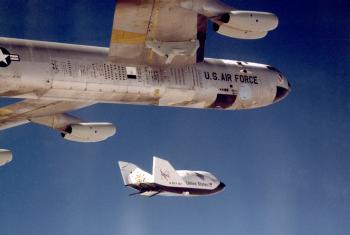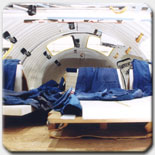
| Home | Bottom |
| SPACE | TRANSPORT: | Spacecraft : | X-38 |
Last Updated : January 14, 2002
The X 38 is NASA's concept design for a 'Lifeboat' to be used on the International Space Station or ISS. As you might have guessed, its primary role will be to get the astronauts back from the ISS in case of an emergency when quick evacuation through other craft is not possible.

The X-38 will be more than just a lifeboat. It will be a viable transport system with the capability to bring back stuff from space in the cheapest and most efficient manner. Before it is fully developed a Russian Soyuz spacecraft will serve this function. Soyuz will become redundant once the space station is fully built and occupied.
Goals and Objectives
The initial application of the new vehicle will be strictly restricted to be used for its lifeboat qualities. However, the CRV will have the capability to be used as a Crew Transport Vehicle or CTV that may be launched to space by Ariane Aerospace's Ariane 5 booster(one of the largest rockets around).
Technology and Working

The CRV will use the innovative "Lifting Body" approach in its design. This technology was perfected in the 1960s by the US and was seen in aircraft like X-24 and especially the HL-10. After re-entry it will open its 5500 sq ft parafoil parachute to glide to earth. Incidently, the parafoil is the world's largest and has been developed by the US army. The landing gear will consist of skids rather than wheels. The craft will be navigate automatically using Global Positioning System / Inertial Navigation System, which is already in use in military aircraft. The crew will have the capability to switch to backup systems, control the orientation in orbit, pick a deorbit site, and steer the parafoil, if necessary. A maximum of seven crew may be accomodated aboard.
Importance and salient features
The CRV will be NASA's most innovative spacecraft in decades . It will actually be its first fully reusable spacecraft after the space shuttle orbiter(!). It uses only existing or 'off the shelf' technology. It might be noted that 'off the shelf' does not mean outdated.
Even NASA knows that cheap and efficient transport must be developed if we are to fully exploit space. They want to prove that a human spacecraft caan be developed at a low cost which will have no precedent. The current cost estimates for the whole program are less than 500 million dollars.
It will also pave the way for the successor to the current space shuttle, Lockheed Martin's Venture Star.
The X-38 project is a joint effort between the Johnson Space Center, Houston, Texas (JSC), Langley Research Center, Hampton, Virginia (LaRC) and Dryden Flight Research Center, Edwards, California (DFRC) with the program office located at JSC. A contract was awarded to Scaled Composites, Inc., Mojave, California, for construction of the X-38 test airframes.

Three X-38 vehicles have been built (designated V131, V132, and V-131R) and are 28.5 feet long, 14.5 feet wide, and weigh approximately 16,000 pounds on average. In March 2000 Vehicle 132 completed its third and final free flight in the highest, fastest, and longest X-38 flight to date. It was released at an altitude of 39,000 feet and flew freely for 45 seconds, reaching a speed of over 500 miles per hour before deploying its parachutes for a landing on Rogers Dry Lakebed.
The free fall tests are done by dropping them from a B-52 "mothership" ,the same kind used to test the X-15.
Due to cost overruns of the ISS Alpha, the CRV had to be dropped out of NASA's 2002 budget. NASA Administrator Dan Goldin even held a preliminary discussions with Japan and Europe about a possible effort to revive the crew return vehicle. It is ot known what came of these talks. NASDA has worked on a similar project - HOPE.
On Dec 17, 2001, the X-38 successfully completed its highest, fastest and longest flight ever at NASA's DFRC. This was X-38's 8th flight test. "Although the production of the crew rescue vehicle for the station is deferred, we are continuing to test and mature these technologies to reduce the technical and cost risk of a future CRV production program", said X-38 Program Manager John Muratore.
| Stats (CRV) | |
| Length : | 30 ft |
| Width : | 14.5 ft |
| Max. Weight : | 2000 lbs |
| Max. Flight Time : | 9 hrs |
| Capacity : | 7 persons |
Also See :
| Spacecraft Tech | : | Lifting Body |
| Aircraft | : | Flying Wing |

Comments or Questions? Mail ST at : [email protected]
| [ Home ] | [ Aircraft ] | [ Explore Space ] | [ Space Stations] | [ Spacecraft Tech ] | [ Spacecraft ] | [ X-Prize ] |
| © Space Transport | Top |